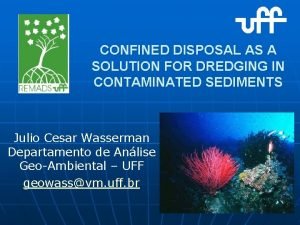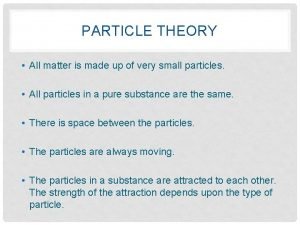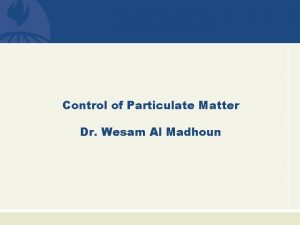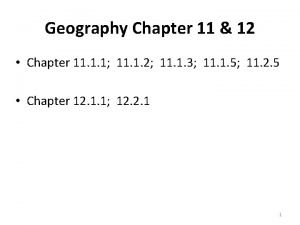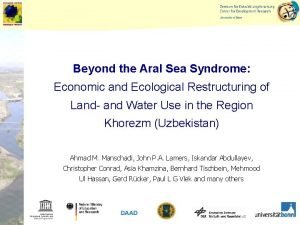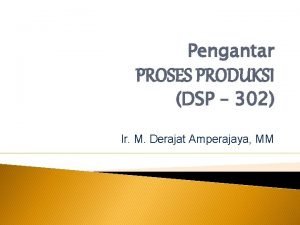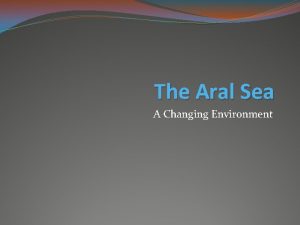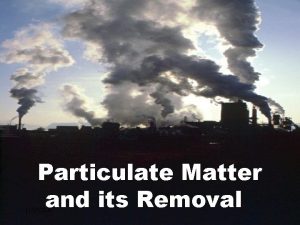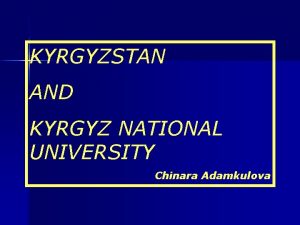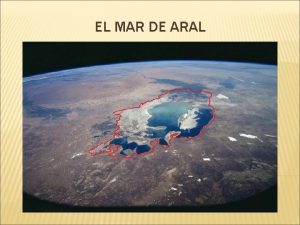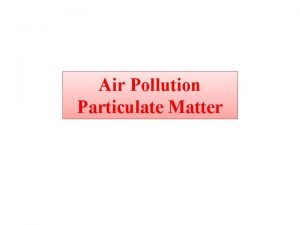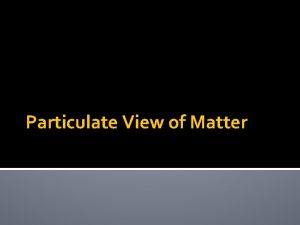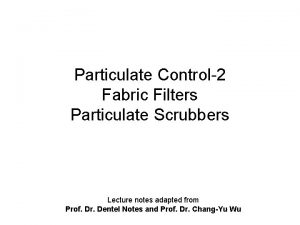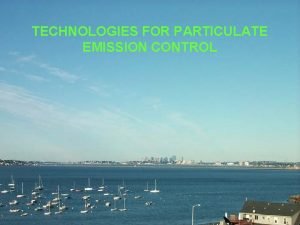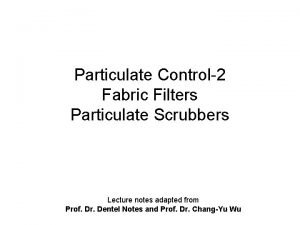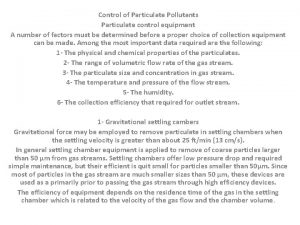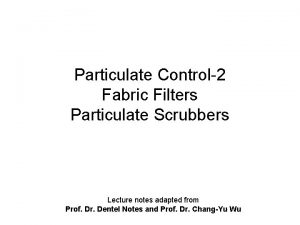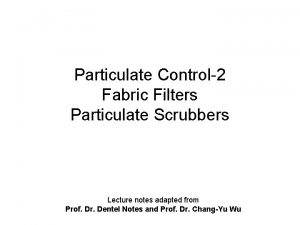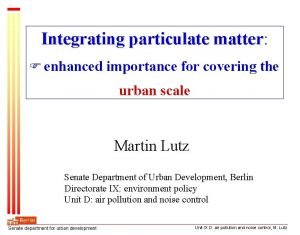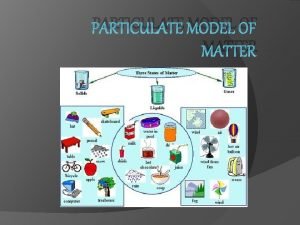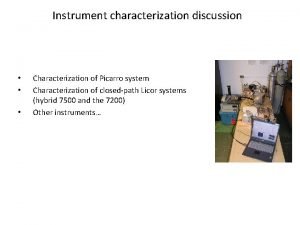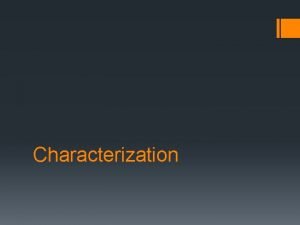Characterization of Aral Sea Particulate Matter in Kyrgyzstan




























- Slides: 28

Characterization of Aral Sea Particulate Matter in Kyrgyzstan Nitika Dewana, Brian J. Majestica, Justin P. Miller –Schulzeb, Martin M. Shaferb, James J. Schauerb, Paul A. Solomonc, Maria Artamonovad, Boris B. Chene, Sanjar A. Imasheve, Greg R. Carmichaelf , Michael Kettererg University of Denver of Wisconsin, Madison CU. S. EPA d. Institute of Atmospheric Physics, Russia e. Kyrgyz-Russian Slavic University f. The University of Iowa g. Metropolitan State University of Denver a b. University 1 A&WMA 25 June, 2014

Why is this important? ØThe Aral Sea is the third largest source of mineral dust in Asia. ØHuman health effects are associated with atmospheric particulate matter (PM) across a range of particle sizes. ØAral Sea sediments emitted into the air may be a previously unidentified source of PM in central Asia. 2

Particulate Matter Ø Mixture of solid particles and liquid droplets in air. Ø Different shapes and varying chemical compositions based on season, source of emission, and origin. Ø Different sizes: PM 2. 5 and PM 10 Ø Can travel thousands of km. Ø To understand the particle’s impact on climate, it is important to study their source, transport, and chemistry. http: //www. air-purifiers-america. com/images/lc_home_air. Particles. Chart. jpg 3

Source Apportionment ØIdentifies general source types responsible for the observed PM. or categories ØDifferent inputs to source apportionment models: 1. organic carbon, elemental carbon, and organic tracer compounds; 2. trace metals and elements; 3. major anions and cations; 4. other water-soluble species. 4

Shrinking of the Aral Sea 68, 000 km 2 28, 687 km 2 8, 160 km 2 5 http: //blogs. voanews. com/science-world/files/2013/02/1_aral_sea. jpg

Dust events in Aral Sea basin Huang Xiangtong et. al. (2011). Quaternary Science Reviews Aral Dust Storm April 10, 2008 (MODIS/Aqua Real Time image courtesy of NASA) 6

Sampling sites Bishkek - 35 km S of Bishkek City Center - Capital, population ~854, 000 - Elevation 1250 m LIDAR - 30 km NE of Karakol - 380 km east of Bishkek - City of ~75000 - Elevation 1920 m 7

Objectives 1. To determine if the metal content of PM from dust-event periods differs that of non-dust event periods at the Bishkek and LIDAR sites. 2. To determine whether the isotopic composition of Aral Sea and Kyrgyzstan soils are distinguishable from those of western and central China. 3. To explore if emissions from Aral Sea sediments are an important source of air pollution to central Asia. 8

Elemental concentrations of soils at Bishkek and LIDAR sites 9

Elemental concentrations in soils from Aral Sea sediments 10

Elemental concentrations in PM 10 collected at Bishkek site 11

Elemental concentrations in PM 10 collected at LIDAR site 12

Source Apportionment Method Enrichment factor (EF): EFX = (Xsample / Refsample) / (Xcrust / Refcrust) Ø Crustal weathering is likely to be the source of the atmospheric concentrations. EF is used to identify anthropogenic components of aerosols in the atmosphere. Ø EF is close to unity for the elements related to the reference, Al (marker for crustal emissions). Ø EF >> 10 if there is an important anthropogenic source for that pollutant. 13

EF of soils and Aral sediments Ø In Aral Sea sediments, elements such as As, Sb, Cr, Ni, and Mo are present due to anthropogenic activities. 14

EF of LIDAR aerosols Ø Elements such as Sb, Cd, As, Cu, and Pb are present due to assumed anthropogenic activities in PM 10 collected during the dust events. Ø Elements like Sb, Cd, As, Cu, Pb, Zn, and Mo are anthropogenically present in PM 10 collected during the non-dust events. 15

EF of Bishkek aerosols Ø Elements such as Sb, Cd, As, Zn and Pb are present due to assumed anthropogenic activities in aerosols collected during the dust events. Ø Elements like Sb, Cd, As, Cu, Pb, Zn, and Sn are anthropogenically present in aerosols collected during the non-dust events. 16

Source Apportionment “A good tracer is detectable, non-degradable, and unique to a source” Ø Sr and Pb do not fractionate during chemical reactions. Ø The atmospheric concentrations of Sr and Pb are very low, so there is little risk of atmospheric contamination. 17 http: //web. sahra. arizona. edu/programs/isotopes/images

Pb Isotope Generation Ø 238 U(t = 4. 466 x 109 years) → 206 Pb 235 U(t 9 207 Pb 1/2 = 0. 704 x 10 years) → 232 Th(t 10 years) → 208 Pb 1/2 = 1. 401 x 10 1/2 ØOld Pb ores have low 206 Pb/207 Pb ratios (1. 06 -1. 10). More recent samples reflect higher 206 Pb/207 Pb ratios (>1. 18). 18

208 Pb/206 Pb Pb isotopic ratio variations b 19 206 Pb/207 Pb M. Komarek et. al. (2008). Env. International

Pb as a tracer Ø Both Kyrgyzstan soils and the Aral Sea sediments have natural Pb. Ø The aerosols collected at both the sites during the dust events and non-dust events have anthropogenic Pb. 20

Pb as a tracer Ø Linearity shows that most Pb is derived from weathered bedrocks. 21

Sr Isotope Generation Ø Both rocks and minerals possess unique 87 Sr/86 Sr ratios. (t 1/2= 47. 5 billion years) decays by β emission to form stable 87 Sr. 87 Rb → 87 Sr + β Ø 87 Rb Ø 87 Sr is a stable and radiogenic isotope; therefore, we would expect increased 87 Sr/86 Sr ratios in old rocks and sediments. 22

Sr isotopic ratio variations Dust 0. 7109 -0. 7112 Snow 0. 7098 Carbonate Recrystallization 0. 7094 Rain 0. 7090 -0. 7131 Limestone/Dolomite = 0. 704 - 0. 709 Granite = 0. 710 Volcanic Basalts = 0. 702 -0. 705 Seawater 0. 70924 Hydrothermal Exchange 0. 7037 Oceans 0. 70916 23

Sr as a tracer Ø The Aral Sea sediments (87 Sr/86 Sr = 0. 70947 -0. 71064) form member “A”. Ø Kyrgyzstan soils (87 Sr/86 Sr = 0. 71448 -0. 71739) form member “B”. Ø Aral sea sediment ratios are indicative of elioan sediments. 24

Comparison of ACE-Asia aerosols and Asia “dust” Ø Sr ratios (0. 71448 0. 71739) for Kyrgyzstan soils indicate that the region has undergone multiple recycling and a thorough sedimentary mixing processes. 25

Conclusions Ø Elemental analyses of resuspendable soils from the Aral Sea region and Kyrgyzstan soils show that the composition of the soils are remarkably uniform. Ø As, Cd, Cu, Sb, Pb were higher in content at both the sites due to assumed anthropogenic activity. Ø The airborne PM collected in Kyrgyzstan may be a mixture of Aral Sea sediments, long-range transport, soils from regional deserts, and local soils. Ø Both Kyrgyzstan soils and the Aral Sea sediments have natural Pb and aerosols collected at the Bishkek and LIDAR sites have anthropogenic Pb. 26

References ü Majestic, B. J. , A. D. Anbar, and P. Herckes. , Stable Isotopes as a Tool to Apportion Atmospheric Iron. Environmental Science and Technology. 2009. 43(12): 4327 -4333. ü Geagea, M. L. , et. al. , Tracing of industrial aerosol sources in an urban environment using Pb, Sr, and Nd isotopes. Environmental Science and Technology. 2008. 42(3): 692 -698 ü Schauer, J. ; Majestic, B. et al. Improved source apportionment and speciation of low- volume particulate matter samples. Rep. Health Eff. Inst. 2010. 153: 3 -75. ü Bentley, R. A. , Strontium isotopes from the earth to the archaeological skeleton: A review. Journal of Archaelogical Method and Theory. 2006. 13(3): 135 -187. ü Capo, R. C. , Stewart, B. C. , and Chadwick, O. A. , Strontium isotopes as tracers of ecosysytem processes: theory and methods. Geoderma, 1998. 82(1 -3): 197 -225. ü The Telegraph. Aral Sea is ‘one of the planet's worst environmental disasters'. http: //www. telegraph. co. uk/earthnews/7554679/Aral-Seaone-of-the-planets-worst- environmental-disasters. html (February 26, 2013). ü Miller-Schulze. J. , et. al, Characteristics of fine particle carbonaceous aerosol at two remote sites in Central Asia. Atmospheric Environment. 2011. 45(38): 6955 -6966 27

Although this work was reviewed by the EPA and approved for presentation, it may not necessarily reflect official Agency policy. 28
 Suspended particulate matter
Suspended particulate matter Particle theory
Particle theory The particulate model of matter
The particulate model of matter Control of particulate matter
Control of particulate matter The western siberian plain __________.
The western siberian plain __________. Aral sea changed over time
Aral sea changed over time Aral sea syndrome
Aral sea syndrome Cbt kirghizistan
Cbt kirghizistan Mga likas na yaman sa hilagang asya yamang lupa
Mga likas na yaman sa hilagang asya yamang lupa Shaping process adalah
Shaping process adalah Is milk macroscopic microscopic or particulate
Is milk macroscopic microscopic or particulate Particulate contamination in infusions
Particulate contamination in infusions Mendelian inheritance
Mendelian inheritance Die blanks ceramics
Die blanks ceramics God of radiation
God of radiation What does direct characterization mean
What does direct characterization mean Direct characterization vs indirect characterization
Direct characterization vs indirect characterization Phylum cnidaria hydra
Phylum cnidaria hydra Marlin symbolism
Marlin symbolism Led soldiers across hellespont into anatolia goals
Led soldiers across hellespont into anatolia goals Sea cave
Sea cave What is asias largest desert
What is asias largest desert Gyrus and sulcus function
Gyrus and sulcus function Grey matter
Grey matter Classification of matter section 1 composition of matter
Classification of matter section 1 composition of matter Flow of energy vs flow of matter
Flow of energy vs flow of matter Composition of matter section 1
Composition of matter section 1 Gray matter and white matter
Gray matter and white matter Chapter 2 matter section 1 classifying matter answer key
Chapter 2 matter section 1 classifying matter answer key
